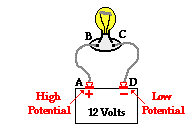Electricity Blog 2
Electricity
Utilize your second period in completing the previous work
Good morning students
Today we will make an effort to --
Develop meaning of potential difference and its unit
Continuing with what was given as Home Assignment
Let us begin today's lesson
The electric charge is equal to the number of electrons in it

WE WILL DISCUSS THE MEANING OF THE WORD
RESISTANCE TOMORROW
HOME ASSIGNMENT :
Read page 201-202
Intext Questions on page 202
Keep Smiling
😃
Utilize your second period in completing the previous work
Good morning students
Today we will make an effort to --
Develop meaning of potential difference and its unit
Continuing with what was given as Home Assignment
Current I = 10 A
Time = 2 minutes = 2 × 60 = 120 sec
(a) Then charge Q = I × t = 10 × 120 = 1200 C
(b) Number of electrons = 1200 C x 1/ 1.6×10−19
= 7.5 x 10−17
= 7.5 x 10−17
The electric charge is equal to the number of electrons in it
and the magnitude of charge on the electron i.e.Q = newhere n = number of electrons ande = charge of electron which is = 1.6 x 10-19 CQ. Calculate number of electrons in 1C of chargeAns) Q= neQ= 1C 1 = n x 1.6 x 10-19n = 6.25 x 1018 Therefore, we can define 1C as : 1C is that charge which contains 6.25 x 1018 number ofelectrons in it.
One coulomb is equal to the quantity of charge that passesthrough a cross-section of a conductor in one second, givena current of one ampere.
Potential DifferenceWork done per unit charge in taking charge from one point toanother is known as Potential Difference.The unit of potential difference is volt (V).1V is defined as the potential difference between two pointsif 1 Joule of work is done to move 1 coulomb charge
from one point to another.i.e. V= W (from one point to another) q1V = 1 joule 1 coulombVoltmeter : The instrument that is used to measure potentialdifference between two points in an electric circuitAmmeter :It is an instrument used to measure the current flowing in anelectric circuit .
A .50JB .15JC .100JD .500JRefer to page 202 Example 12.2.Answer will be discussed tomorrowRead the chapter further and do some research so as toanswer the following.We will do it tomorrowQ) How can we get continuous flow of current in acircuit?Ans) We can get continuous flow of current in a circuit bymaintaining a potential difference between the 2 ends of aconductor. We can do that by connecting it to a battery or cellbecause there are two terminals that are always at differentpotential levels.

WE WILL DISCUSS THE MEANING OF THE WORD
RESISTANCE TOMORROW
HOME ASSIGNMENT :
Read page 201-202
Intext Questions on page 202
Keep Smiling
😃





Good morning Sir
ReplyDeleteAdavya Dhir
good morning sir
ReplyDeletesharon santhosh
Good morning sir
ReplyDeleteHarsh vardhan
good morning sir
ReplyDeleteGood morning sir
ReplyDeleteGood morning sir
ReplyDeleteGood morning sir
ReplyDeleteGood morning sir
ReplyDeleteGood morning sir
ReplyDeleteSahej Grover
Good morning sir
ReplyDeleteEugene Samuel
Good morning sir
ReplyDeleteSiddhartha kushwaha
Good morning sir
ReplyDeleteEmmanuel gomes
Good morning sir
ReplyDeleteAryan Anand
Good morning sir Arvind Goyal
ReplyDeleteGood morning sir
ReplyDeleteShaurya Shil
Good morning sir
ReplyDeleteBennett Joy
Good morning sir
ReplyDeletekennard Rence William
Good morning sir
ReplyDeleteSidh Chichra
Good afternoon sir
ReplyDeleteJatin James
PRESENT
ReplyDeleteGood Afternoon Sir🙏🙏
ReplyDelete-Pratham Chhabra
10-D
Good afternoon sir
ReplyDeleteSiddhartha k
Good morning sir
ReplyDeleteJoel Reji
good morning sir
ReplyDeleteGood afternoon sir
ReplyDeleteTuan Muan Lal
good afternoon sir
ReplyDeleteGood Afternoon Sir
ReplyDeleteGood afternoon sir
ReplyDeleteJapmann singh